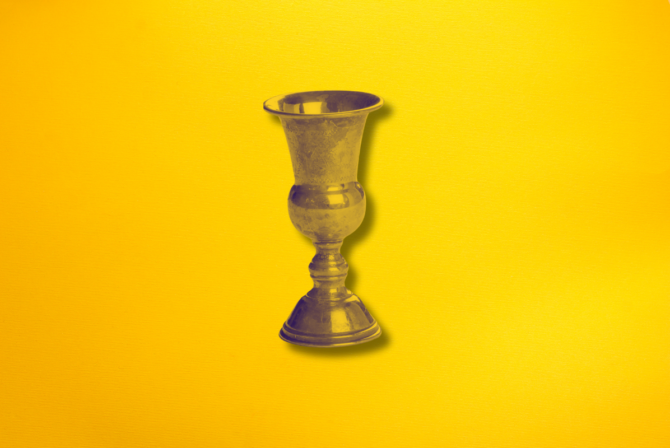I learned to braid and to bake at the same time. At my mother’s side, we mixed packets of yeast with warm water to let it proof, melted butter and stirred it together with eggs, milk, and honey, and added flour to make it a soft, pliable dough. She got the recipe for this sweetened and enriched challah from a roommate’s great-grandmother, who brought it with her from Europe.
“Push it away with the heel of your hands, then fold it over and pull it towards you,” she instructed, teaching me how to knead the dough. After the dough was springy and resilient, we placed it in a greased bowl to rise in a warm place. In the fall and winter, which is when we most often made honey-egg bread, we placed it on the edge of the kitchen counter, closest to the woodstove in the next room. We swaddled the bowl in a dishtowel.
After an hour, we lifted back the towel to see the dough, puffed out to double its size. My mother told me to punch it down, and we pried it out of the bowl and kneaded some more. She then cut it into equal pieces, three or six, depending on how many loaves we were making, or if we were making one big braid with a baby braid on top. We shaped each piece into a long, skinny snake, rolling on a floured board or between our hands in the air. Our golden retriever lay at our feet, hopeful for a dropped piece of dough.
My mother arranged three snakes parallel to each other on the board, pinching them together at the tops. “Now we take right over middle, left over middle,” she said. “Right over middle, left over middle.”
With this as our mantra, we braided down the strands. We brushed the loaf with a milk wash and baked it. We enjoyed the sweet, chewy bread with winter vegetable stews or toasted for breakfast.
This was the bread recipe I asked for when I started cooking my own meals in a tiny shared kitchen in college. This was the dough I mixed during finals, when I needed a respite from stress and studying. I made it in Boston, usually when I was feeling lonely or had suffered some sort of perceived or actual slight or setback. When we moved to a rural Maine island, I baked several loaves of it as gifts and we drove around delivering them on Christmas Eve. This was the bread with which I started my tiny seasonal bakery. Eight braided loaves on a tablecloth at the weekly ball field farmer’s market, which has grown now to full service breakfast, including bagel sandwiches and French toast, made with the honey-egg bread. I’ve tweaked the recipe somewhat, but it remains essentially the same. And right over middle, left over middle is in my head with each and every loaf.
Right over middle, left over middle. My mother used the same chant as she braided my hair at night after a bath, or to go to school on gym days. I used the same one to teach my husband how to braid my hair when I hurt my hand during a theater production. I used it to teach my neighbor’s youngest daughter how to braid honey-egg bread when she started hanging around the bakery, helping out and eventually apprenticing. I chant it to my baking students, too, adults and teens hoping to bring that particular offering, freshly baked bread, into their homes.
My husband and I found out December 23 that we are having a girl. I know that whether I am teaching her to braid hair or bread or both, I will use the same words: right over middle, left over middle, and continue the line of teaching and tradition.
Adapted slightly from the original by Courtney Naliboff
For two loaves:
1 cup of milk
Two packets or 4 1/2 teaspoons of active dry or instant yeast
5 tablespoons of honey
2 tablespoons of melted butter
2 eggs
3 cups of white all-purpose flour, plus additional for dusting and kneading
A pinch of salt
Warm the milk to blood temperature. In a large bowl, combine the warm milk, melted butter, yeast, honey and eggs. Whisk to combine. Allow the liquid mixture to sit for a few minutes until it becomes foamy from the yeast’s activity. Add the salt and flour, one cup at a time, stirring and then using your hand to incorporate it thoroughly. After all of the flour is incorporated, begin to knead the dough. Add additional flour as needed to make a soft, pliable dough and knead it for a few minutes until it is springy but no longer sticky. Shape the dough into a ball and dust it with flour, putting it in a clean bowl to rise. Cover the bowl and put it in a warm place to rise for about an hour, or until it is doubled in sized. This will take less time in a very warm room. Punch down the risen dough and turn it out onto a floured board. Knead it some more. Divide the dough into six pieces – each piece will weigh between 5 and 6 ounces, if you are using a scale. Otherwise just eyeball them to make them approximately equal. At this point, if you want to do a big braid and a little braid instead of two equal loaves, make three bigger pieces and three smaller pieces. Shape each piece into a ball, and then roll it out into a snake. There are two ways you can braid:
Method 1: Lay three snakes parallel to each other on a floured surface. Pinch them together at the top. Begin braiding right over middle, left over middle, braiding the strands tightly. When you reach the bottom, pinch the strands together tightly again. You can tuck the ends of the loaf under slightly. This method sometimes produces a narrower end and a wider end to the loaf.
Method 2: Lay three snakes parallel to each other on a floured surface. Rather than pinching them together at the top, begin braiding in the middle – right over middle, left over middle – until you reach the bottom of the loaf. Pinch the strands together. Resume braiding from the middle up, this time working right under middle, left under middle until you reach the top of the loaf. Pinch the strands together. This produces a more consistent width down the loaf.
If making one extra fancy loaf with two stacked braids, simply braid the big and then the little braid, and place the little braid on top of the big braid.
Preheat the oven to 350° (325° if using a convection oven). Allow the braids to rest, with plenty of space between them if making two loaves, on a greased baking sheet, loosely covered with a clean cloth or saran wrap. Once the oven is done preheating and the braids are pufy from their second rise, you can brush them with a milk or egg wash, decorate them with sesame and/or poppy seeds, or leave them unadorned.
Bake for 30 minutes, or until golden brown on top and hollow-sounding when tapped on the bottom. The internal temperature, if using a thermometer, will read 180°. Enjoy by itself, as a sandwich bread, soup accompaniment, or truly decadent French toast!
Like this post? Get the best of Kveller delivered straight to your inbox.









